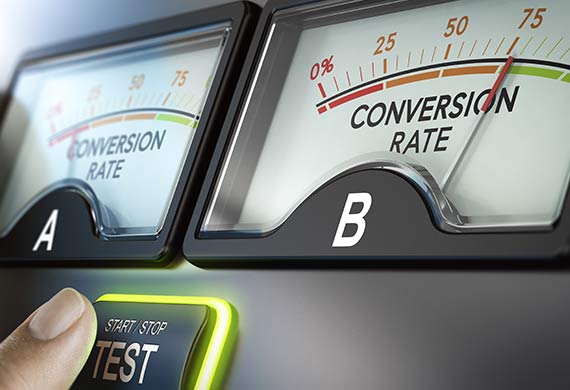Prevent underperforming web pages and marketing campaigns to cause your business to lose money and potential sales. By knowing how to test and optimize your website's conversion rates, you can boost your revenue and subsequently grow your business.

clashgraphics.com gathered information about split testing, why you should run a split test, and the simple steps to follow.
The Definition of Split Testing
Split testing, also known as A/B testing, helps marketers and business owners increase website conversions and sales. It accomplishes this end by comparing two versions of a webpage or landing page (the original or “control,” and a variation), and through a testing process clearly see which performs better.
Under optimal conditions, there will only be one difference between the two pages, so the results can better identify the cause behind any change in performance. To give you an example, say you want to know if having a video at the top of your webpage is more effective than just having an image, you would create 2 versions of the same webpage, with the only difference being one shows the image, and the other the website. Thus, when comparing the conversion rate of these 2 variations over a period of time, you would know the clear winner because the only difference would be this (image vs video) variable.
Split testing is the performance of a controlled experiment. This methodology is used for deriving results from more than just web pages. The concept of split (A/B) testing began with direct mail and print advertising, which were tracked using different phone numbers for each version of the advertisement.
Nowadays, you can split test banner ads, text ads, television commercials, printed media campaigns, email subject lines, and any other marketing strategy. All you need is a hypothesis (ie. what you want to test), a control version, and a variation.
What Can Be Split Tested?
You can test just about anything that your visitors see and/or hear. The following are some of the more commonly tested elements:
- Ad locations and sizes
- Product images
- Product descriptions
- Product prices
- Call-to-action locations/colors
- Recommended content
- Outgoing links
- Checkout steps/process
- Content length
- Social sharing buttons
- Site search
This is a shortlist of the elements you can test. Your conversion rates can be influenced by anything your visitors interact with. Split testing will aid you in determining what works best and in what position it is most effective.

Why Should I Run Split Tests?
If you are to comprehend why your visitors are not converting, you must ask yourself which content is dissuading your visitors from converting. Let’s face facts, intuition isn’t enough and your bias will cause you to lose money in most situations. Ultimately, what matters is the effect on your visitors, their behavior, and the numbers they will provide you a clear answer.

By performing a split test, you allow your visitors to persuade the decision-making process for changes to your control page. Results obtained from split testing will help you know which version they interact with the most, and, which information and design transforms them into first-time or repeat customers.
Simplified, split tests provide data on your customers / website user experience to help identify friction, barriers to more sales, and to optimize your conversion funnel, eliminating guessing and lost revenue.
Split Testing Steps
Since data and numbers will guide you to the answers, having data analytics software connected to your website is a prerequisite. Once you have this covered, start with the changes that have the potential to make a significant impact on your conversion rate, and follow these steps:
Step 1 - Define Your Purpose
Study your website data. What weaknesses can you determine from your current metrics? For example - If your webpage 'bounce rate' is too high, consider that your headline and feature image may not be captivating enough to keep your visitors interested. Or perhaps, the messaging in your advertising and landing page don’t match, leaving your visitor feeling misled or confused.
Step 2 - Develop Your Plan
Once you have defined a clear sticking point, identify the possible ways it can be improved. For this example, let’s say you want to lower your bounce rate. By formulating a more compelling headline and using a more relevant feature image, your intent is to persuade your visitor to read more of the webpage / offer, ultimately leading to more conversions.
Using split testing metrics, you can confirm or reject the effectiveness of such change.
Step 3 - Determine a Sample Size
You’ll need to determine your sample size to help you reach statistical significance. The term “statistical significance” refers to the number of visits to each page (control and variation) needed to reach a reasonable conclusion about your results.
Essentially, think and determine how many customers need to visit and use each version of your webpage test before you are able to make a decision and choose a clear winner based on the data (ex. 5 people choosing version A of your test wouldn't provide the same confidence as if 500 people chose version A)
You can avoid a sampling error by increasing the amount of traffic you drive to your control and variation equally, and making sure that you are driving traffic from your ideal and intended target audience. In simple terms, if you are selling car parts on your website, make sure your traffic pool / visitors are coming from a source of car enthusiasts and owners.
Step 4 - Avoid Outside Influencers
Take the time to scrutinize things like traffic sources and referring ads. To ensure the accuracy of your test, these traffic sources must be the same for both pages (A vs. B). Given different traffic sources can create misleading data, you need to be be alert as to other variables that could affect the integrity of your test. The following factors can severely skew your test results:
- Calendar events like Christmas, Easter, Halloween, etc.
- Website outage or server problems
- Positive or negative news about your product, website, or business
- Broken links or inactive CTA buttons
- Significant changes to search engine algorithms
- Application or removal of search engine penalties
- Changes in control or variation settings
- Changes in the purpose or plan of your test
While addressing potential outside influences before testing is highly recommended, such obstacles can appear unexpectedly so be on the lookout for anomalies in the data. They should be taken into consideration before and after running your test.
Step 5 - Drive Traffic to Your Pages
Unless you are split testing your traffic sources or ads, you should make sure the traffic, sent to your control and variation, is coming from the same source/demographic.
Keep running your test until you reach the sample size, as determined in step 3. If you reach the sample size in less than seven days, continue the test until the week is complete. Different days of the week significantly impact conversions, and this information can be helpful to your current and future campaigns.

Step 6 - End Your Test and Analyze The Data
Once your test is complete, you can make decisions (based on the data) about changes to your control page. Keep in mind that if the 'lift' (increased outcome) from your variation was smaller than your minimum target/goal, you might need to rerun the test for a longer period of time, or with a different variation.
If your variation failed to produce a better result / 'lift', or it was out-performed by your control, don’t consider this a failure. You have just discovered a component that doesn’t impact conversions on your control. Return to step 1, identify a new purpose, and run your next test.
Split Testing To Improve Conversion
In this article, you discovered what split testing is, the value it can contribute to your business, and the steps involved in running effective tests.
By running split tests, you can quickly identify and change factors that increase visitor conversions. Likewise, you can verify those attributes that do not affect conversion rates.
Without running split or AB tests, you may be forfeiting revenue and losing opportunities to grow your business.
Sources:
hbr.org/2017/06/a-refresher-on-ab-testing
mailchimpapp.org/marketing-glossary/ab-tests/
hbr.org/2016/02/a-refresher-on-statistical-significance
Clash Graphics Print Shop Atlanta Flyer Printing
2233 Peachtree Rd NE Ste 202 Atlanta, GA 30309
(678) 235-3464
To view the original version on Clash Graphics, visit: https://www.clashgraphics.com/printing-tips/what-is-split-testing-website/
No comments:
Post a Comment